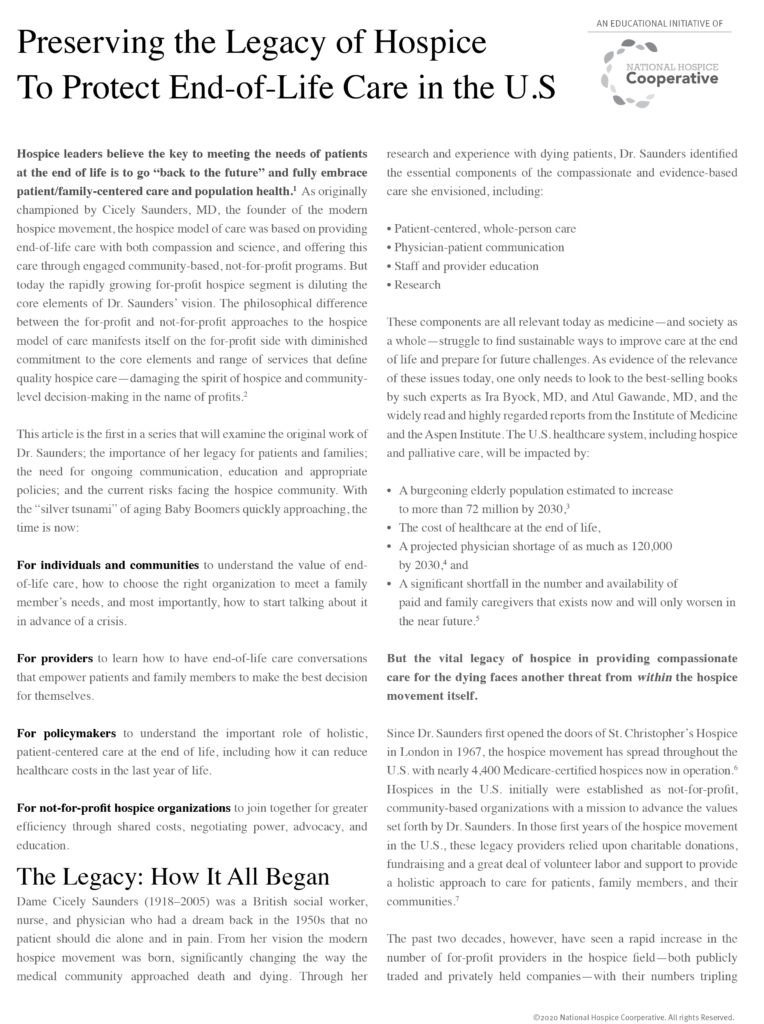Hospice Compare: Input and Advocacy: Hospice Leaders’ Opportunity to Guide the Process Given that both…

Is end-of-life care threatened by today’s healthcare environment? – Part 1
1.
Is end-of-life care threatened by today’s healthcare environment? – Part 1
Preserving the Legacy of Hospice To Protect End-of-Life Care in the U.S.
Hospice leaders believe the key to meeting the needs of patients at the end of life is to go “back to the future” and fully embrace patient/family-centered care and population health.1 As originally championed by Cicely Saunders, MD, the founder of the modern hospice movement, the hospice model of care was based on providing end-of-life care with both compassion and science, and offering this care through engaged community-based, not- for-profit programs. But today the rapidly growing for-profit hospice segment is diluting the core elements of Dr. Saunders’ vision. The philosophical difference between the for-profit and not-for-profit approaches to the hospice model of care manifests itself on the for-profit side with diminished commitment to the core elements and range of services that define quality hospice care—damaging the spirit of hospice and community-level decision-making in the name of profits.2
- For individuals and communities to understand the value of end-of-life care, how to choose the right organization to meet a family member’s needs, and most importantly, how to start talking about it in advance of a crisis.
- For providers to learn how to have end-of-life care conversations that empower patients and family members to make the best decision for themselves.
- For policymakers to understand the important role of holistic, patient-centered care at the end of life, including how it can reduce healthcare costs in the last year of life.
- For not-for-profit hospice organizations to join together for greater efficiency through shared costs, negotiating power, advocacy, and education.
This article is the first in a series that will examine the original work of Dr. Saunders; the importance of her legacy for patients and families; the need for ongoing communication, education and appropriate policies; and the current risks facing the hospice community. With the “silver tsunami” of aging Baby Boomers quickly approaching, the time is now:
The Legacy: How It All Began
Dame Cicely Saunders (1918–2005) was a British social worker, nurse, and physician who had a dream back in the 1950s that no patient should die alone and in pain. From her vision the modern hospice movement was born, significantly changing the way the medical community approached death and dying. Through her research and experience with dying patients, Dr. Saunders identified the essential components of the compassionate and evidence-based care she envisioned, including:
- Patient-centered, whole-person care
- Physician-patient communication
- Staff and provider education
- Research
These components are all relevant today as medicine—and society as awhole—struggle to find sustainable waysto improve care at the end of life and prepare for future challenges. As evidence of the relevance of these issues today, one only needs to look to the best-selling books by such experts as Ira Byock, MD, and Atul Gawande, MD, and the widely read and highly regarded reports from the Institute of Medicine and the Aspen Institute. The U.S. healthcare system, including hospice and palliative care, will be impacted by:
- A burgeoning elderly population estimated to increase to more than 72 million by 2030,3
- The cost of healthcare at the end of life,
- A projected physician shortage of as much as 120,000 by 2030,4 and
- A significant shortfall in the number and availability of paid and family caregivers that exists now and will only worsen in the near future.5
But the vital legacy of hospice in providing compassionate care for the dying faces another threat from within the hospice movement itself.
Since Dr. Saunders first opened the doors of St. Christopher’s Hospice in London in 1967, the hospice movement has spread throughout the U.S. with nearly 4,400 Medicare-certified hospices now in operation.6 Hospices in the U.S. initially were established as not-for-profit, community-based organizations with a mission to advance the values set forth by Dr. Saunders.
In those first years of the hospice movement in the U.S., these legacy providers relied upon charitable donations, fundraising and a great deal of volunteer labor and support to provide a holistic approach to care for patients, family members, and their communities.7
The past two decades, however, have seen a rapid increase in the number of for-profit providers in the hospice field—both publicly traded and privately held companies—with their numbers tripling between 2000 and 2012 while the number of not-for-profit providers has remained relatively static.8 According to a healthcare mergers and acquisitions firm, hospice is a “hot commodity” now as “investors are looking at the silver tsunami of aging baby boomers and want to have skin in the game.”9 In fact, care of the dying has blossomed into a multi-million dollar industry for for-profit companies and their investors10 as the for-profit sector has grown exponentially.
But recent research suggests that some for-profit hospices may be threatening the survival of the not-for-profit sector, diminishing the legacy of care envisioned by Dr. Saunders to seize an unfair advantage in the marketplace.11
This article examines the foundation of care envisioned by Dr. Saunders, provides an overview of the current challenges facing hospice, and assesses how preserving Dr. Saunders’ legacy can help meet these challenges. In addition, this article will examine recent studies analyzing the contrast between the for-profit and not-for-profit approaches to care of the dying.
Despite considerable progress, significant problems remain in providing end-of-life care for Americans that is high quality and compassionate and preserves their choice while being affordable and sustainable.12



